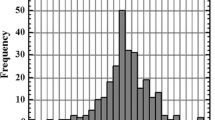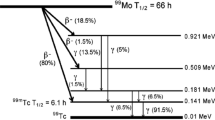Abstract
Twenty-one ready-to-use hobby glazes, of which 18 were labeled “safe for food containers” (SFFC), were analyzed for Al, B, Ba, Ca, Cd, Co, Cr, Cu, Fe, Gd, Hf, K, Mn, Na, Pb, Si, Sm, Sr, Ti, Zn, and Zr by neutron capture prompt γ-ray activation analysis (PGAA). Simultaneously, Pb was also determined by X-ray fluorescence spectrometry (XRFS) using Pb K X-rays induced by the γ-ray component of the neutron beam. The XRFS limits of detection were 200–400 μg Pb·g−1 (dry weight), a factor of ∼ 100 better than those for PGAA. Pb concentrations (by dry weight; with weight losses ranging from 28 to 49% after air-drying) found were 0.16–27.2% in the SFFC glazes and 0.86–32% in the other glazes. The SFFC glazes contained from <0.6 to 202 μg Cd·g−1, and Co, Cr, and Cu (elements which may enhance Pb leaching from fired glazes) were found in concentrations up to 1.2, 2.7, and 5.6%, respectively. Method accuracy was demonstrated with the analysis of soil, fly ash, and glass standard reference materials.
Similar content being viewed by others
References
Official Methods of Analysis, Association of Official Analytical Chemists, 15th Ed., Arlington, VA, 1990, sec. 973.32.
Fed. Regist. (July 6, 1992) 57 (129), 29734.
“Pottery (Ceramics); Imported and Domestic — Lead Contamination,” Food and Drug Administration Compliance Policy Guide, FDA, Washington, DC, 1992, sec. 7117.07.
“Pottery (Ceramics); Imported and Domestic — Cadmium Contamination,” Food and Drug Administration Compliance Policy Guide, FDA, Washington, DC, 1988, sec, 7117.06.
D.L. ANDERSON, W.C. CUNNINGHAM, T. R.LINDSTROM, J. AOAC Int., in press (1995).
M.P. FAILEY, D.L. ANDERSON, W.H. ZOLLER, G.E. GORDON, R.M. LINDSTROM, Anal. Chem. 51 (1979) 2209.
D.L. ANDERSON, Y. SUN, M.P. FAILEY, W.H. ZOLLER, Geostand. Newsl. 9 (1985) 219.
M.P. FAILEY, Ph.D. Thesis, University of Maryland, College Park, MD, 1979.
D.L. ANDERSON, E.A. MACKEY, J. Radioanal. Nucl. Chem., 167 (1993) 145.
P. BERTIN, Principles and Practice of X-Ray Specrometric Analysis, 2nd Ed., Plenum Press, New York-London, 1975.
E.S. GLADNEY, B.T. O'MALLEY, I. ROELANDTS, T.E. GILLS, NBS Special Publication No. 260-111, 1987.
L.A. CURRIE, Anal. Chem., 40 (1968) 586.
“Lead Glazes for Dinnerware” in ILZRO Manual, Ceramics 1, International Lead Zinc Research Organization, New York, 1974.
Author information
Authors and Affiliations
Rights and permissions
About this article
Cite this article
Anderson, D.L. Ceramic glaze analysis by simultaneous in-beam PGAA and XRFS. Journal of Radioanalytical and Nuclear Chemistry, Articles 192, 281–287 (1995). https://doi.org/10.1007/BF02041732
Issue Date:
DOI: https://doi.org/10.1007/BF02041732




